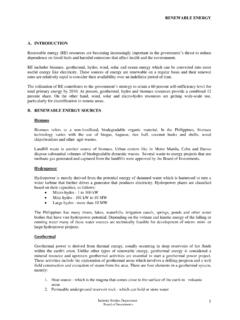Transcription of THE PHILIPPINE PETROCHEMICAL INDUSTRY PROFILE
1 THE PHILIPPINE PETROCHEMICAL INDUSTRY PROFILE . 1. petrochemicals are organic compounds derived from petroleum raw materials (called naphtha) or natural gas or a derivative produced from such a substance by chemical reaction, , ammonia, carbon black and thousands of organic chemicals. A significant stream of the PETROCHEMICAL product tree consists of what are commonly referred to as plastics or synthetic resins. 2. The INDUSTRY is a strategic and basic sector because of its linkages to upstream, midstream and downstream sectors. This strong linkage provides multiplier effects on enterprises and the economy as a whole. The above Figure 1 shows the sector essentially providing inputs to other major sectors of the economy which themselves create auxiliary and other support industries.
2 There are several businesses which are entirely dependent on petrochemicals and other components which are based on PETROCHEMICAL inputs. This key feature of this strategic material leads to growth and greater demand for manufacturing facilities, logistics, suppliers and exporters. 3. Product coverage Table 1. Existing Product Coverage of the Midstream PHILIPPINE PETROCHEMICAL INDUSTRY CODE DESCRIPTION MFN Rate (%) ATIGA (%). Polyethylene having of less than , in 10 0. primary forms Polyethylene having of more, in primary 10 0. forms Other polymers of ethylene, in primary forms 3 0. Polypropylene, in primary forms 10 0. Propylene copolymer, in primary form 10 0.
3 Polymers of other olefins, in primary forms 3 0. Other polystyrene, in primary forms 10 0. Other polymers of styrene, in primary forms 3 0. Polyvinyl chloride homopolymer, suspension type, in 10 0. primary form Other polyvinyl chloride, not mixed w/ oth substance, 10 0. CODE DESCRIPTION MFN Rate (%) ATIGA (%). in primary forms Polyvinyl chloride, plasticized, in primary forms 10 0. 4. Products' uses PE, PP, PS and PVC are raw materials used in the manufacture of plastic finished products. Most are sold in pellet form, although some are also sold in powder form. Table 2 shows the uses of the various plastic resins. Table 2. Uses of Plastic Resins PLASTIC RESIN FINISHED PRODUCTS.
4 Polyvinyl Chloride Construction supplies such as rigid pipes and fittings, window frames, doors (PVC) and jambs, insulation for electric wires and cables, corrugated roofs, gutters and downspouts ; films and sheets such as shower curtains, table cloths, book covers and other school supplies, and household items such as floor tiles, linoleum, flexible hoses, upholstery materials, wall covers, tarpaulin, toys, etc.; in the medical field, it is used for blood bags and tubings and other related medical materials Polystyrene Cups, fastfood eating utensils, CD cases, appliance casing and parts, (PS) packaging foam, casing and parts for electronic gadgets such as TV sets, radio, stereos, etc.
5 Polypropylene Sacks, toys, adhesive tape, cigarette packaging, pails, furniture, jumbo bags, (PP) tarpaulins, strapping, food containers, ropes, snack packaging, parts for appliances and electronic gadgets, cosmetic bottles, etc. Polyethylene Shopping bags. Garbage bags, sack liners, toys, pallets, crates, housewares, (PE) food containers, lubricating oil containers, plastic pipes, drums, etc. (Source: petrochemicals Roadmap). 5. The total PETROCHEMICAL investment in the country is estimated to exceed USD 2 billion with over 2,808,600 MT per year total capacity in polymer production. JGSOC has the biggest investment share for all the seven major PETROCHEMICAL plants in the Philippines, with USD 800 million initial investments.
6 Current capacities are as follows: Table 3. PETROCHEMICAL Plants Currently Operating in the Philippines COMPANY PRODUCT CAPACITY PLANT LOCATION. PHILIPPINE Polypropylene, Inc. (PPI) PP 160,000 MT Bataan PP 175,000 MT. JG summit PETROCHEMICAL Corporation Batangas PE 180,000 MT. NPC Alliance PE 250,000 MT Bataan PHILIPPINE Resins Industries, Inc. PVC 100,000 MT Bataan (expandable to 200,000 MT). PS 30,000 MT. Unsaturated 10,200 MT. Polyester (UPH). Chemrez Technologies, Inc. Quezon City Polymer 14,400 MT. Emulsions Methyl Ester 60,000 MT. The PHILIPPINE PETROCHEMICAL INDUSTRY PROFILE (as of 13 March 2017) Page 2 of 5 pages Propylene 140,000 MT. Benzene 20,000 MT.
7 Petron Corporation Bataan Toluene 150,000 MT. Mixed Xylene 220,000 MT. Source: petrochemicals Roadmap Additional investments in the PETROCHEMICAL INDUSTRY would include the currently approved projects of JGSPC by the BOI, as follows: Table 4. BOI Approved Projects of JGSPC and JGSOC (December 2016). Activity Capacity (in MT/year) Project Cost (PhP). Butadiene and 70,000 4,212,622,000. Raffinate 89,000. Benzene, 126,000 3,052,519,000. Toluene, 76,000. Mixed Xylene, 76,000. C8+/C9+ Cut, 18,000. Non-Aromatics 29,000. Polypropylene resins 120,000 2,828,172,000. Bimodal polyethylene 251,712 10,018,431,000. Ethylene, 160,002 8,644,188,000. Propylene, 51,000.
8 Mixed C4, 26,418. Pygas 78,876. These projects will be in commercial operations by July 2021. 6. The major players of the INDUSTRY employ around 1,215 employees directly and 1,822 workers indirectly. With the addition of upstream projects being constructed and expansion plans, direct and indirect employment is estimated to reach more than 5,000 by 2014. 7. Per the Association of PETROCHEMICAL Manufacturers of the Philippines (APMP), the Philippines has two producers of polyethylene (PE), summit petrochemicals Corp. (JGSPC) and NPC. Alliance Corporation, and two producers of polypropylene (PP), summit petrochemicals and PHILIPPINE Polypropylene Inc.
9 For polyvinyl chloride (PVC), there are two producers, , PHILIPPINE Resins Industries, Inc. and General Chemicals and Resins Consortium Inc (non- member) while for polystyrene (PS) the two active producers are Chemrez Technologies (D & L. Industries, Inc) and SMP, Inc. (non-member). Petron Corporation and JG summit Olefins Corp. (JGSOC) are manufacturers that produce monomers such as ethylene, propylene, benzene, toluene and mixed xylene. Petron supplies 100% of its propylene production to its sister company, PHILIPPINE Polypropylene Inc. which produces polypropylene resins. While the naphtha cracker of JGSOC supplies the ethylene and propylene monomer requirements for the PP and PE plants of JGSPC.
10 8. The PETROCHEMICAL INDUSTRY uses the following raw materials: The PHILIPPINE PETROCHEMICAL INDUSTRY PROFILE (as of 13 March 2017) Page 3 of 5 pages Raw Material Usage Source Ethylene For the production of PE JGSPC. Propylene For the production of PP JGSPC. Styrene For the production of PS Taiwan Vinyl Chloride For the production of PVC Japan, Taiwan 9. Gross Value Added (GVA, in million pesos). Year 2013 2014 2015 2016. GVA (chemicals & chemical products) 184,363 191,229 220,901 240,265. Total Manufacturing GVA 1,538,913 1,666,515 1,760,988 1,883,922. % Share to Total Mfg. GVA Source: PSA. 10. Trade performance (exports and imports). Table 4.




